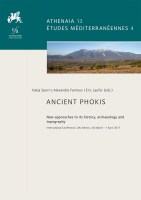Search
Editors: Sporn, Katja; Farnoux, Alexandre; Laufer, Eric
ANCIENT PHOKIS
New approaches to its history, archaeology and topography. International conference, DAI Athens, 30 March–1 April 2017
2024
21.0 x 29.7 cm, 536 p., illustrations b/w, illustrations color, paperback / softback
ISBN: 9783752008258
21.0 x 29.7 cm, 536 p., illustrations b/w, illustrations color, paperback / softback
129,00 €
ISBN: 9783752008258
Short Description
This volume offers a comprehensive insight into ancient Phokis, a region in the heart of Greece. Its history was always shaped by the political and cultural influences of neighbouring powers. The diverse landscape provided space for the existence of numerous mostly small poleis. Thanks to its oracles in Delphi and Abai and the formation of a koinon, Phokis was closely integrated into supra-regional communication, trade and cultural networks. The book presents current research findings that offer a broad overview of the history and culture of the region and point to future research perspectives.Description
As a region in the heart of ancient Greece, Phokis was of central importance for transport and travel. Politically and culturally, it was thus often exposed to the interests and influences of neighbouring powers. The Phokian landscape is also diverse: from the bay of Antikyra on the Corinthian Gulf to the mighty massifs of Parnassos and Helikon, from the barren hills to the fertile river plain of Kephissos.A considerable number of mostly small poleis shaped the political landscape. In Delphi and Abai (Kalapodi), two oracles exercised an early impact far beyond the borders of the country. This integrated Phokis into the supra-regional networks of communication, trade, politics, and cultural exchange. Under the pressure of more powerful neighbours, the Phokians came together in a koinon early on, already in the Archaic period. The ›Third Holy War‹ fought in and around Phokis around the middle of the 4th century B.C. ultimately led to the establishment of Macedon as a new hegemonic power, thus setting the course for a new epoch in Greek history. The koinon of the Phokian poleis remained influential in the political and social development of the countryside, albeit in a changed form and significance until well into the Imperial Period.
The tenth book of Pausanias gives a rich impression of the urban diversity, as well as the wealth of religious, mythological, and cultural traditions of Phokis. In the archaeologically tangible evidence on the ground, the image of Phokis today is dominated by numerous well-preserved, impressive fortifications set mainly on prominent hillsides. In contrast, residential buildings, public architecture and sanctuaries as well as necropoleis in the cities are only partially known. The systematic excavations in Delphi and Kalapodi, however, have provided rich and uniquely detailed insights into the history and material culture of these important sanctuaries.
A substantial amount of recent fieldwork is contributing significantly to expanding our picture of ancient Phokis. This volume of the International Conference held in Athens in 2017, jointly organised by the German Archaeological Institute and the École Française d'Athènes, brings together for the first time a cross-section of this current research: from the Iron Age to the Early Byzantine period. It tackles topics covering historical matters to settlement archaeology, sacred topography, material culture, and the architectural design of the sanctuaries; analyses of individual matters and broad material genres, and enquiries into aspects of a particular ›Phokian‹ identity. Thus, for the first time, a broad overview of the previous research tradition, desiderata, and new perspectives for future research into ancient Phokis is provided.




 Preface
Preface

 Neuerscheinungen 2023/2024
Neuerscheinungen 2023/2024
 Gesamtverzeichnis 2023/2024
Gesamtverzeichnis 2023/2024
 Katalog Oriental Studies & Linguistics
Katalog Oriental Studies & Linguistics
 Mittelalter
Mittelalter
 Deutsche Inschriften
Deutsche Inschriften
 Musiktherapie
Musiktherapie
 Literaturen im Kontext
Literaturen im Kontext